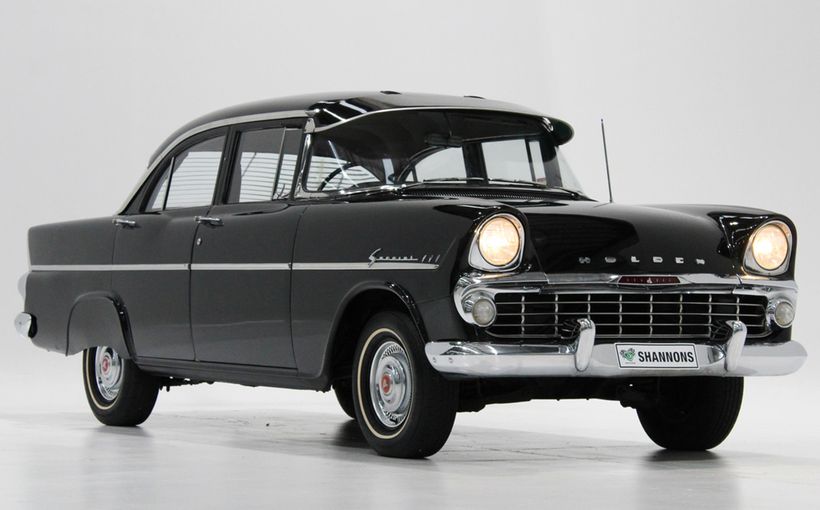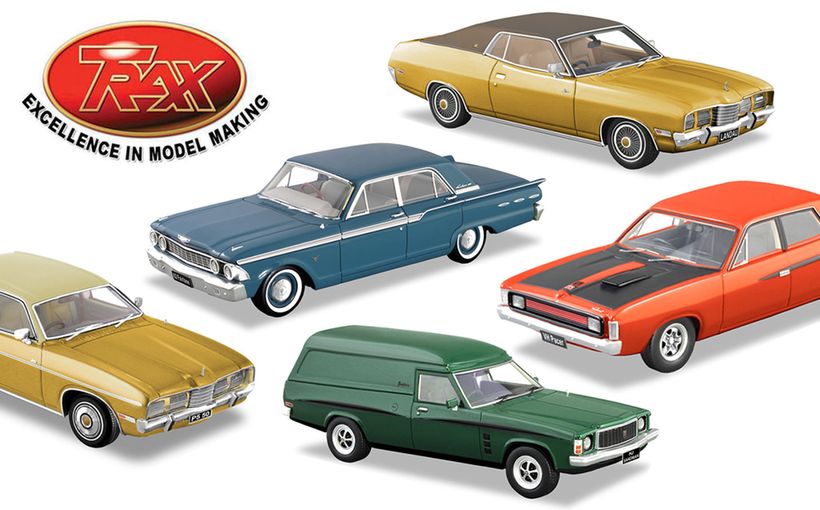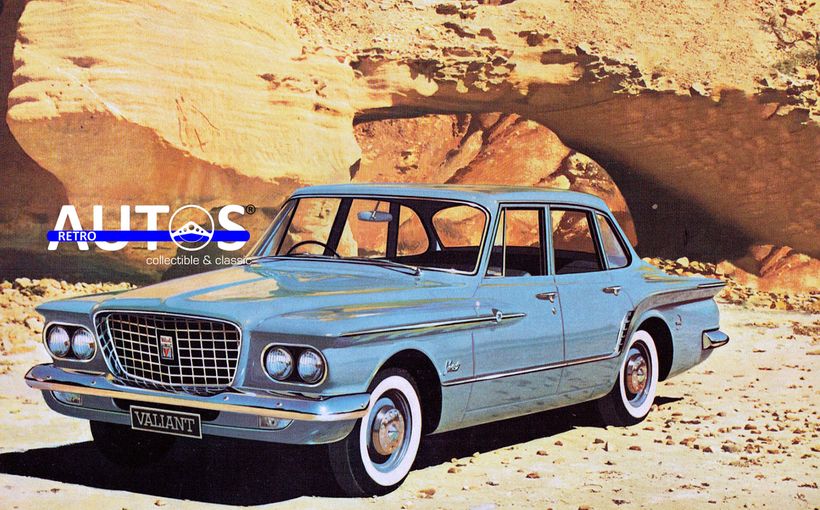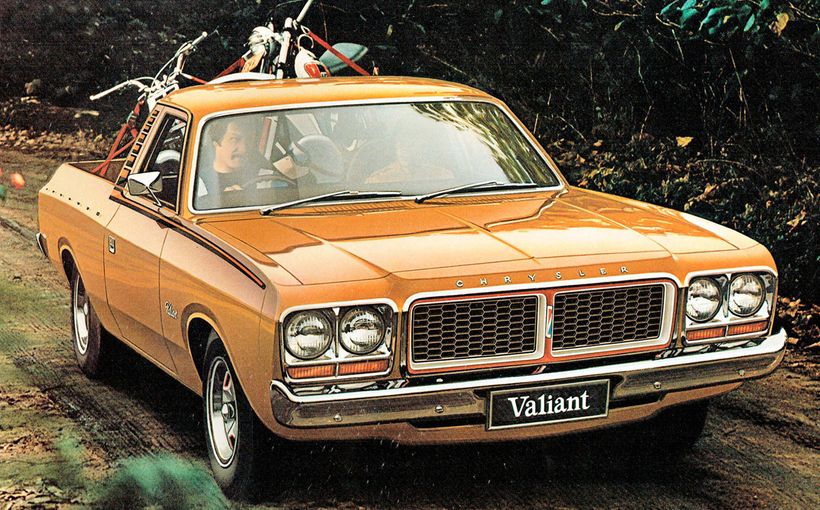1962-63 Chrysler R/S Series: Too Good to Live

The impact of the first local Valiant’s arrival on January 18, 1962 when the EK Holden still had another six months to run was seismic. It was the first Australian family six to move the bar in almost every area since the 1948 arrival of the first Holden. Before most Australians had a chance to save for the brilliant new R Series or its rushed S Series facelift, the radical new shape was gone by May 1963. The shock of its arrival was matched only by its sudden departure and the ordinariness of its replacement.
The R and S Series Valiant story highlights everything right about the Chrysler Corporation's engineering in the 1950s, albeit for a LHD market only. It then highlights how disruptive superficial annual US facelifts and badge-engineering had become and how both were counter-productive to genuine improvements.

After Chrysler defined new levels of engineering and style for the Valiant’s 1960 US model year release, it was forced to abandon most of the new model’s advances within three years. Market forces dictated that it had to be replaced with something that looked different, a process that also forced Chrysler Australia’s hand in a market more concerned about long term substance. Chrysler’s original ingenuity and better engineering took a back seat to window-dressing and marketing.
As Valiants in the US and Australia became superficially-changed variations of the bland 1963 model, the Valiant was doomed to never be more than just another car.
It was an appalling outcome that ultimately led to the loss of Chrysler Australia after the Valiant’s fate shadowed the Chrysler Royal, a new body that offered few advances over the ten year old model it was based on. On a wider scale, the story of the original Valiant also highlights how the US industry surrendered the foundations to build competitive small cars to Japan and Europe for a post-oil crisis market.

The Body
There can be little doubt that the first Valiant was the most advanced affordable compact family car in the world in 1960. The detailing in the body alone was breathtaking. Chrysler was the global leader in automotive stress analysis techniques.
It was a direct Chrysler Royal replacement in Australia, a version of the once fresh full-size 1953 Plymouth that was the target for the Valiant to match in the US. On a 106-5 inch/2705mm wheelbase (longer than a Holden’s, shorter than a Falcon’s), it had to match the internal width and length of the big Plymouth and its classmates. For abandoned local Ford Customline owners, it was a better replacement than the 1962 Falcon and much closer to the new compact Fairlane of the same year in key areas.
A radical new structure featured rugged torque-boxes integral to the structure, a generation ahead of the Falcon, linked by five cross-members, with almost every body part adding to torsional strength including the front shock towers, inner guards, radiator yoke and the upper-edges of the bolt-on front guards. There were 5300 spot welds. Bonnet and boot lid featured sturdy internal reinforcement panels. Even the fake spare wheel cover on the early Q (not seen here) and R Series added strength.

It delivered a structure 95 per cent stiffer in torsion and 50 per cent stronger in beam than the full chassis 1959 Plymouth. Chrysler Australia did not have to go it alone on a local re-engineering program like the first Holden or Falcon. The first Valiant was built strong enough from the start for almost any global market.
The body skin was influenced by Chrysler’s liaisons with Ghia under Virgil Exner for a true trans-Atlantic look that looked at home equally in Europe, Australia and the US. Unlike other externally inspired designs, this one was finessed by Chrysler experts. It was the first compact anywhere with revolutionary fuselage sides that blended into the roof in an unbroken line.
Not quite as slick as GM’s later curved side glass designs, the doors featured slimline door hardware to allow space for angled tracks within the doors. These sent the glass up at an angle eliminating the external ledges required with vertical glass. Unlike later Valiants, there were no ledges to eat into cabin width. In Australia, this approach pre-dated Holden’s similar HD door treatment by three years.

Early in the Valiant’s development, it was identified that a sleek, low-waist body in a compact family car would normally be capped by a tall glasshouse to accommodate full-size occupants. This gave most smaller cars during this era a gawky, tall look. Because the Valiant had to appear at home amongst the much longer and wider low-slung cars on US roads, bringing the Valiant glasshouse into scale with the lower body was a priority.
A low, flat roofline, very close to a coupe from the outside, was supported by eight straight but thin pillars that framed an extra rear side window. Chrysler moved the roof’s strengthening ribs to the outside then styled them into the rest of the body. This left the door entry height and width of a full-sized car in a body which, viewed on its own, looked much bigger and sleeker than it was. The first Falcon by comparison had a tall glasshouse on a body that looked too shallow.

The bonus was moving the front and rear screen pillars out of the driver’s field of vision and using glass that curved around the sides to meet them. The clever pillar and glass design generated a 306 degree field of vision at driver’s eye level. The benchmark proportions, details and vision as sketched for the body design brief were remarkably close to the HQ Holden a decade later.
Sloping the rear glass into the boot lid was also radical at the time, allowing the boot lid to abut the rear screen. The slope of the rear glass created extra length and height under the glass for an exceptionally big boot.
The heavily creased side panels which added strength dictated several new tooling and production processes which ultimately made it more difficult (and costly) to generate annual facelifts that looked different.

There was a downside. This sleek Valiant sedan body left little margin for the later pillarless hardtop version to look sleeker and lower than the sedan costing valuable incremental sales against Ford’s popular new Falcon hardtop spin-off in the US. It was a problem shared with the later Holden HQ sedan and the Monaro coupe version.
Outcome: Despite the structural quality and the unusually high owner satisfaction levels, this first Valiant struggled on the US market from day one compared to its rivals. In 1960 it generated 194,292 sales versus the 435,676 of the runaway early Ford Falcon, a car that was disposable by comparison in the Australian context. By 1961, sales had pegged to 143,078 versus 474,000 Falcons, a drop partly generated by the availability of a new competing Dodge Lancer version, which looked different enough from the 1960 Valiant for some buyers to swap over.

The Corvair suffered a similar fate after US planners mistakenly thought that import sales were being driven by their unconventional styling and engineering. The Falcon demonstrated that the size and price were more critical and that US buyers were just as happy to buy a smaller car with the simplicity and styling of US large cars. This forced Chevrolet to offer the Chevy II in 1962 adding to the Valiant’s woes.
The 1962 Valiant recovered slightly to 157,294 units with 9000 Australian, 1700 Swiss and 1500 Swedish sales contributing to much of this increase.
The more conventionally-styled US 1963 Valiant was already locked-in under Exner before his replacement, ex-Ford designer Elwood Engel could influence it. It’s clear that internal turmoil had undermined Exner’s nerve to deliver something different. It immediately boosted sales to 225,000, an indicator of the power of annual changes that made the car look different. A new front repeated this success in 1964 but by 1965 it was running out of steam and never fully recovered.

Although the 1963 Valiant retained the original Valiant’s structure, as did the AP5 Australian version, it lost most of its advanced body features and individuality, a factor that ultimately made the Valiant less attractive to export markets. Chrysler Australia was forced to develop its own local AP5 version to restore the boot capacity and the big car presence of the original Valiant it was replacing.
In the process, the AP5 took on a generic look that placed it on par with the current local Holden and Falcon relying only on its bigger engine and slightly better detailing to justify its price premium. In reality, Holden’s new 179 engine matched the performance of the Valiant’s much bigger 225 engine without the fuel consumption penalty. The AP5 cabin could not provide the extra passenger room that buyers were looking for, an expectation driven by the bigger engine and boot.
Alternative: Smoothing out the original Valiant’s body while maintaining the original long bonnet, short boot proportions with a more integrated HQ Holden look might have been more successful in Australia. As a 1963 or 1964 model, it would have arrived as a trend-setter alongside the Mustang in the US. Adding matching curved side glass to the original’s curved door profile in 1963 would have given Chrysler a jump of several years over General Motors and Ford rivals. By the time local Valiants matched this in 1971, it was all over. An increase in wheelbase to at least 108 inches/2743mm in 1963 would have been useful in closing the gap on the Chevy II and Falcon in the US with similar benefits in Australia. It was a strategy that delivered a 25 per cent increase in sales for the Aussie VE Valiant in 1968, a development that arrived too late in the US.

Safety and Equipment
This is where the first Valiant was visibly better and no more so than in Australia. In 1962, the EK Holden presented a sharp and imposing metal dash that could inflict serious injuries on occupants, a flat steering wheel attached to a steering column known to impale drivers against the seat and a fixed rearview mirror harmful to centre passengers.
The first Valiant introduced a deep-dished steering wheel, safety door locks, seat cushion retainers, built-in seat belt anchorages, double ball-joint safety rearview mirror, fully-boxed roof headers and rails supported by straight line pillars for unprecedented rollover protection and an inboard fuel tank protected by the underfloor spare immediately behind it. The flatter dash panel with padding was located further away from occupants than usual.
Standard features included dual headlights, reversing lights, twin horns, twin sun visors with passenger mirror, armrests on all doors, dash-mounted interior light switch, an alternator three years ahead of Holden, and a full set of minor instruments including fuel, water temperature and ammeter.

The bigger 14 inch wheels on local cars were seen as a plus. Australians marvelled at the push button auto transmission selector as it highlighted the simplicity of an automatic option still new to most Australians.
Although local versions didn’t get the lavish combination upholstery and full door trims of upper US models, the pleated local seats in UV-resistant Nylex vinyl were seen as classy and durable. Clever curved runners tilted the seat as it was moved to change the angle as well as reach and a trim tensioner in the rear of the front seat boosted rear leg room.

Outcome: In Australia and export markets, this combination worked really well. The only downside was the sharp instrument binnacle of the R Series which featured prominent blanks that highlighted the absence of a heater and auto push buttons if they were missing. This dash continued into the local S Series instead of the benchmark 1962 US instrument panel. The biggest omission was a bonnet lock, its external release hidden as the grille badge on the R Series but more visible in the S Series grille. By 1963, more features were gone eroding the cut-above Valiant positioning at entry level.
Alternative: This is the point where facelift money should have been spent on decent face level flow-through ventilation, a feature denied to local and export Valiants for its entire history. Windscreen washers should have been standard. Although a heater/demister would have been welcome as standard, it was not yet regarded as essential standard equipment at entry level.

Mechanical Features
The first Valiant moved the bar in this area in an astonishing number of different ways. A purpose-designed slant six allowed a lower bonnet profile for such a big displacement and a high-torque long runner inlet manifold. It was inclined a full 30 degrees away from a US driver while the transmission was tilted the other way to lower the transmission tunnel for the passenger area. Both were also mounted off-centre away from the driver in LHD applications for even weight distribution.
The manual’s gear lever was floor-mounted on the driver’s side of the transmission tunnel directly into the side of the gearbox on LHD models. This further reduced the height of the transmission tunnel and cleared an open space for the centre passenger’s legs while allowing for a sporty manual floor shift.

A lightweight, scale version of Chrysler’s Torque-Flite automatic slashed weight by 49kg and also kept the centre tunnel low. It retained three ratios versus the two speeds in its latest US rivals.
The light thin-wall cast iron engine was also engineered to maximize cabin space and reduce overhang while retaining chassis balance. The water pump was moved to the side and the wasted space between engine and grille was minimized. An aluminium block was an option in the US. There were claims of a lower centre of gravity for less body roll.

The drum brakes were the latest “duo-servo” type which used the weight of the car to build braking power. The brake drums were flanged on the ends and finned to avoid fade.
Although limited in diameter by the US model’s standard 13 inch wheel, the drums’extra width generated a massive 153.5 square inch lining area compared to the Holden’s 95 and Falcon’s 114 figures.
Torsion-bar double wishbone front suspension with properly specified ball joints, hypoid differential and direct but light steering were welcome advances. A “highly asymmetrical rear leaf spring design” with more of the spring behind the rear axle “played a major part in controlling body roll, acceleration squat, and brake dip.”

The Valiant’s superior power was a big factor. The standard 170 cu in/2.8-litre engine was equivalent to the larger Falcon Pursuit engine in power and capacity. The bigger 225/3.7-litre version (the base engine with a one inch longer stroke) was limited to the bigger Plymouth Savoy and Dodge Dart models. It was offered only in the 1961 Dodge Lancer version of the Valiant before it became an option on the 1962 US Valiant S Series.
This engine was no relation to the four-barrel 170 Hyper-Pack hot mill despite the similar 148 bhp/110kW output to the 225’s 145bhp/108kW. There was also a 225 Hyper-Pack with a claimed 196bhp/146kW. Period media claims that Chrysler had fitted the local R Series with the hotted-up version of the US Valiant engine was clearly not the case.
It was never more than the bigger cooking engine initially reserved for the bigger models later offered in US Valiant-based models. The confusion arose because the model Australians knew as the R Series had the bigger engine as standard in Australia before it was even offered as an option in the following US version of the S Series!
It is believed this occurred because if Chrysler Australia succeeded in replacing the ancient side valve six version of the Chrysler Royal with the Valiant, the Valiant’s new six then had to replace the same flathead in local Dodge light commercials. The bigger version was chosen for both applications.

Outcome: Given that the Valiant had the potential to save its Australian division from imminent closure (which it did later) and create the best RHD Chrysler entry ever for the abandoned UK market, all British Commonweath countries in Africa, Asia and other Pacific Rim markets, this strategy was unbelievably short-sighted.
After Australians ignored US advice that a RHD version was impossible, the Valiant went on to become the biggest seller in South Africa achieving Holden-like status and loyalty in that country. However, the compromises while achieving this unnecessarily damaged the Valiant’s prospects in the short and long term. It also delayed the preparation of the original Valiant for RHD hence its short export model life.

This cost the US company at least three years of big RHD sales that could have been at least 60,000 annually as it took until 1964 for RHD production to fully catch up from the disruption of the US 1962-63 model changes.
Chrysler Australia was forced to move the engine slightly away from the side of the engine bay back to centre then mount the oil filter on the body joined by flexible hoses which wasn’t ideal. Even then the steering parts were a tight squeeze. The S Series gained a more permanent oil filter location with metal oil lines.
A special local heater demister also had to be developed. Weight distribution side to side was less than ideal. The early floor change was also a challenge and while it looked like a mirror conversion from inside, the linkages had to cross under the gearbox making them vulnerable on Aussie roads. The journey across and under the car introduced a vagueness which defeated the purpose of a direct floor shift.

The lack of synchromesh on first gear led to further compromises for the smaller US engine then stunted the performance of the big new 225 engine allowing local rivals with smaller engines to match it. First gear was a stump puller of little use once on the move so second was lowered to fill that gap. The resulting huge gap to top gear then squandered the bigger engine’s torque advantage. Local 14 inch wheels specified for extra clearance and more relaxed cruising actually added to the problem by making third even taller.

The US switch to a column shift in 1962 addressed the linkage issues on the local S Series but the wrong ratios still added to the manual’s thirst and gaps in acceleration. A standing quarter of 20 seconds was appalling for a car this powerful (and thirsty) yet once in third, its 160km/h plus top speed and easy cruising in top gear was legendary and remained unbeaten for some time. Although the Australian Valiant was the first of its type to offer standard synchromesh on first with the 1966 VC facelift the manual was a local Valiant handicap until then.

If the Valiant had been introduced in Australia and South Africa in 1960, both markets could have shared a unique version based on the original (as they did much later) and not followed the downgrading of the US model.
The inclined, off-centre engine location also prevented vital new steering upgrades in the US 1962 Valiant from being applied to RHD models. This included a new steering box bolted directly to the revised 1962 front K-member/frame instead of the body’s box-section.
When both compromises were never addressed in Australian Valiants, it not only harmed the Valiant but bordered on corporate irresponsibility. On early slant six Valiants, it was not easy to keep an eye on the steering box and its flawed mounting-point. As power and grip increased over the years, Valiant steering became more vague and the fatigue and rust generated by the ever growing loads on the steering box’s body mounting were potentially lethal.

Alternative: The deep air-cleaner and battery location suggests that the engine could have been raised to at least 20 degrees from the vertical and centred without impacting on the packaging or inlet manifolding. Australia’s later Hemi 6 engine demonstrated that this was possible without creating too much drama after it was slipped into the VG engine bay without change.
This would have allowed a symmetrical heating and ventilation system, interchangeable brake master cylinder and consistent turn-in from both directions. Most importantly, the vital 1962 steering upgrade could have been applied to all RHD models until the end.
The column gear change of the 1962 series was acceptable for the era but a centre-mounted three-speed floor change option for bucket seat models as fitted to later Aussie Valiant Pacers would have been a good compromise in both LHD and RHD markets. The bottom line was that the Valiant should have featured synchro on first from the start. A four speed manual without synchro on first (which was common at the time) was another solution to tightening the spread of ratios.
Building a proper RHD Valiant from the start and using it as an advance party for more US-developed small cars might have saved Chrysler from the destructive and unproductive purchases of the ailing Rootes Group and what was left of Simca in France.

Branding
Internal politics at Chrysler were as damaging and as toxic as they were at Ford in the 1940s. The impact was predictably similar except unlike Ford, Chrysler never fully recovered.
Although Chrysler Australia was forced to address some of these issues much earlier than the US by consolidating its local range around the Chrysler badge, the steady decline in US product ultimately left Chrysler Australia nowhere to go after the Valiant platform had been left to languish for so long.
Even in Australia, branding of Chrysler’s prestige model as a Dodge Phoenix above the Chrysler Valiant made little sense especially when later Dodge Phoenix models sold in Australia were re-badged Plymouths Local Valiant utes were also sold as Chryslers and Dodges while other commercials during this time carried the Dodge name exclusively.
If a tiny market like Australia couldn’t make its Chrysler model range and branding consistent, similar problems in the US were crippling and reflected a loss of vision and leadership.
The Valiant appeared as a new standalone brand, a potential mistake when Chrysler was already struggling to differentiate Dodge, De Soto, Plymouth and Chrysler itself. If other high quality small cars were added to the Valiant range, it could have worked but for many US buyers, the absence of an established brand name attached to a Valiant was a negative.
GM’s Saturn brand faced similar challenges as it can appear that the parent corporation is not prepared to place its established reputation behind such a radically new and different product. The highly-regarded Chrysler name in Australia gave the first local Valiant instant credibility which held-up until US problems killed it.
The upside was that the first Valiant was so good (once early build quality was sorted) and classless enough to share the showroom with any 1960 Chrysler product as the advertising openly highlighted. As an export, it was good enough to appear as a Dodge, De Soto, Plymouth or Chrysler, or whichever brand had the best local loyalties. Chrysler advertised it as “no one’s kid brother”.

Internal US politics saw the Valiant branded as a Plymouth by 1961 joined by a more upmarket version badged as the Dodge Lancer. In US terms, this plunged the Valiant into the entry level of the lowest-status mainstream US brand (Studebaker and Rambler didn’t rate at this point as neither fielded entries in the biggest-selling US categories). With the minor body changes in 1961 and 1962, this created the impression that Chrysler was just clearing the Valiant experiment under the Plymouth banner as it didn’t look like other Plymouth models. It was also now the Dodge’s kid brother.

Outcome
For 1963, the Plymouth Valiant was the even plainer and now smaller version compared to a bigger Dodge Lancer which created a huge problem for those export markets which had to maintain the original’s elite presence.
The Dodge Lancer was given the longer wheelbase that the local Valiant needed but 1963 Australian roads would have exposed any loss of body rigidity and the extra overhang.
As shown in Gavin Farmer’s book Great Ideas in Motion, this prompted Chrysler Australia to graft the 1963 Dodge Lancer’s more imposing front on the rear of local AP5 sheet metal with a view to selling it as the Dodge Regal. It looked silly and was quickly dropped but the idea was resurrected for the VE Valiant which featured a US Dodge Dart front grafted to a stretched VC Valiant rear.
Alternative: There wasn’t any for Chrysler. In the US context, there was no point investing big resources in a brand new Plymouth compact or stretched Dodge version beyond 1964. GM came to the same conclusion with the Chevy II/Nova waiting until 1968 to re-define it as a purpose-built 111 inch wheelbase model after the new Camaro took care of the previous Chevy II market.
The Mustang and its massive sales soon displaced the smaller sub-111 inch wheelbase entry level compacts. The compact Fairlane with its extra wheelbase and width (along with its rival Chevrolet Chevelle) over the compacts became the new entry family car of choice but both were too big as mainstream Australian family cars.
In an ideal world, both the local and US Valiant by 1968 needed to be purpose-built and strengthened with the same dimensions as the Holden HK Kingswood/Ford XR and XT Falcon/Chevrolet Nova. Because Ford’s 1966 Falcon started as a 111inch wheelbase version of the bigger US Fairlane, it was engineered as a big car unlike the 111inch wheelbase Dodge Dart which was still a stretched early Valiant.
Chrysler Australia needed the VH Valiant in 1969 after its VE-VF-VG series was left with a wheelbase considerably shorter than the 1960 Falcon. By the time the 111 inch wheelbase VH did arrive in 1971, it was still compromised by the lack of flow-through ventilation, dated styling, the offset engine and wrong steering box location. There was no money or anything in the US Mopar line-up to replace it as Chrysler US was even further behind.
The US move away from the popular early compact sedans in favour of the Mustang and its pony car rivals came back to haunt the entire US industry after OPEC turned off the oil taps in 1973.
To meet surging new demand for a compact sedan in 1974, the early Valiant-based 1967 Dodge Dart had to be recycled yet again. This time it emerged as a new Valiant on a 111inch wheelbase so it could double pathetic Valiant sales, up to 127,430, or about half that of the 1963-64 Valiants. If it wasn’t for the Plymouth Duster variant, it would have been curtains for Plymouth and Chrysler.
This 1974 US Valiant highlighted how far even the Australian industry had drawn ahead by staying with the same class of car. The Europeans and Japanese by then had steadily perfected their smaller cars over much longer model cycles and never looked back.











Comments